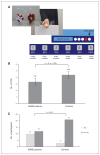Reduced activation in the ventral striatum during probabilistic decision-making in patients in an at-risk mental state
- PMID: 25622039
- PMCID: PMC4409434
- DOI: 10.1503/jpn.140191
Reduced activation in the ventral striatum during probabilistic decision-making in patients in an at-risk mental state
Abstract
Background: Patients with schizophrenia display metacognitive impairments, such as hasty decision-making during probabilistic reasoning - the "jumping to conclusion" bias (JTC). Our recent fMRI study revealed reduced activations in the right ventral striatum (VS) and the ventral tegmental area (VTA) to be associated with decision-making in patients with schizophrenia. It is unclear whether these functional alterations occur in the at-risk mental state (ARMS).
Methods: We administered the classical beads task and fMRI among ARMS patients and healthy controls matched for age, sex, education and premorbid verbal intelligence. None of the ARMS patients was treated with antipsychotics. Both tasks request probabilistic decisions after a variable amount of stimuli. We evaluated activation during decision-making under certainty versus uncertainty and the process of final decision-making.
Results: We included 24 AMRS patients and 24 controls in our study. Compared with controls, ARMS patients tended to draw fewer beads and showed significantly more JTC bias in the classical beads task, mirroring findings in patients with schizophrenia. During fMRI, ARMS patients did not demonstrate JTC bias on the behavioural level, but showed a significant hypoactivation in the right VS during the decision stage.
Limitations: Owing to the cross-sectional design of the study, results are constrained to a better insight into the neurobiology of risk constellations, but not prepsychotic stages. Nine of the ARMS patients were treated with antidepressants and/or lorazepam.
Conclusion: As in patients with schizophrenia, a striatal hypoactivation was found in ARMS patients. Confounding effects of antipsychotic medication can be excluded. Our findings indicate that error prediction signalling and reward anticipation may be linked to striatal dysfunction during prodromal stages and should be examined for their utility in predicting transition risk.
Figures


Similar articles
-
Reduced activation in ventral striatum and ventral tegmental area during probabilistic decision-making in schizophrenia.Schizophr Res. 2014 Jul;156(2-3):143-9. doi: 10.1016/j.schres.2014.04.020. Epub 2014 May 13. Schizophr Res. 2014. PMID: 24831391
-
Evaluation of the 'Jumping to conclusions' bias in different subgroups of the at-risk mental state: from cognitive basic symptoms to UHR criteria.Psychol Med. 2016 Jul;46(10):2071-81. doi: 10.1017/S0033291716000465. Epub 2016 Apr 20. Psychol Med. 2016. PMID: 27094404 Clinical Trial.
-
Ventral striatal hypoactivation is associated with apathy but not diminished expression in patients with schizophrenia.J Psychiatry Neurosci. 2016 Apr;41(3):152-61. doi: 10.1503/jpn.140383. J Psychiatry Neurosci. 2016. PMID: 26395814 Free PMC article.
-
Jumping to conclusions in schizophrenia.Neuropsychiatr Dis Treat. 2015 Jul 1;11:1615-24. doi: 10.2147/NDT.S56870. eCollection 2015. Neuropsychiatr Dis Treat. 2015. PMID: 26170674 Free PMC article. Review.
-
[Decision-making and schizophrenia].Encephale. 2011 Dec;37 Suppl 2:S110-6. doi: 10.1016/S0013-7006(11)70036-7. Encephale. 2011. PMID: 22212839 Review. French.
Cited by
-
The Importance of Metamemory Functioning to the Pathogenesis of Psychosis.Front Psychol. 2017 Mar 6;8:304. doi: 10.3389/fpsyg.2017.00304. eCollection 2017. Front Psychol. 2017. PMID: 28321200 Free PMC article. Review.
-
Activation of Internal Correctness Monitoring Circuitry in Youths With Psychosis Spectrum Symptoms.Biol Psychiatry Cogn Neurosci Neuroimaging. 2023 May;8(5):542-550. doi: 10.1016/j.bpsc.2023.01.010. Epub 2023 Feb 2. Biol Psychiatry Cogn Neurosci Neuroimaging. 2023. PMID: 37019760 Free PMC article.
-
Nothing to lose? Neural correlates of decision, anticipation, and feedback in the balloon analog risk task.Psychophysiology. 2024 Dec;61(12):e14660. doi: 10.1111/psyp.14660. Epub 2024 Aug 1. Psychophysiology. 2024. PMID: 39090795 Free PMC article.
-
Probabilistic Category Learning and Striatal Functional Activation in Psychosis Risk.Schizophr Bull. 2019 Mar 7;45(2):396-404. doi: 10.1093/schbul/sby033. Schizophr Bull. 2019. PMID: 29590478 Free PMC article.
-
Psychosis risk is associated with decreased white matter integrity in limbic network corticostriatal tracts.Psychiatry Res Neuroimaging. 2020 Jul 30;301:111089. doi: 10.1016/j.pscychresns.2020.111089. Epub 2020 May 15. Psychiatry Res Neuroimaging. 2020. PMID: 32442837 Free PMC article.
References
-
- Lysaker PHP, Warman DMP, Dimaggio GM, et al. Metacognition in schizophrenia: associations with multiple assessments of executive function. J Nerv Ment Dis. 2008;196:384–9. - PubMed
-
- Lysaker PH, Gumley A, Luedtke B, et al. Social cognition and metacognition in schizophrenia: evidence of their independence and linkage with outcomes. Acta Psychiatr Scand. 2013;127:239–47. - PubMed
-
- Moritz S, Woodward TS. Jumping to conclusions in delusional and non-delusional schizophrenic patients. Br J Clin Psychol. 2005;44:193–207. - PubMed
Publication types
MeSH terms
Substances
LinkOut - more resources
Full Text Sources
Other Literature Sources
Medical
Research Materials
